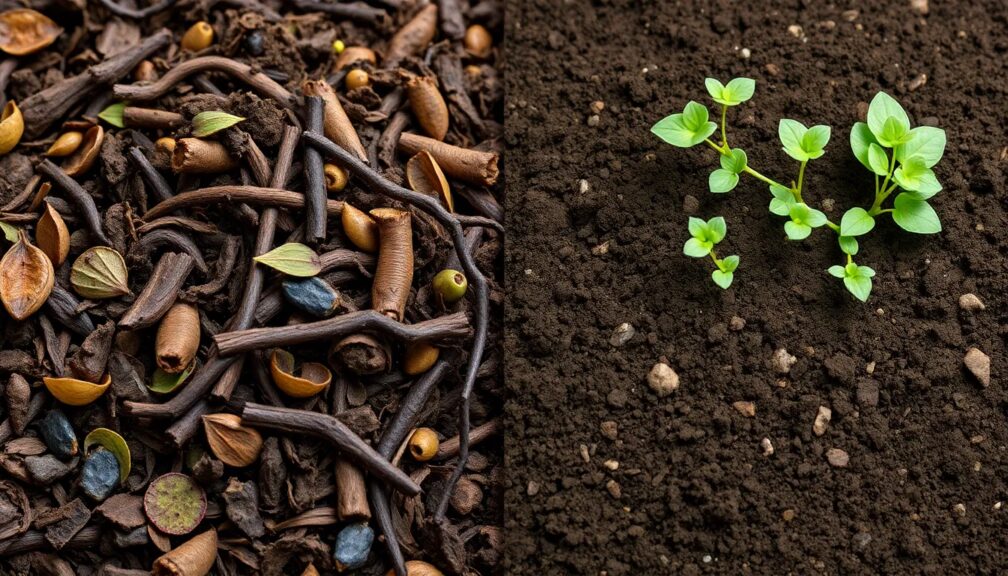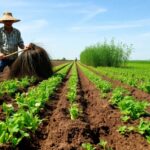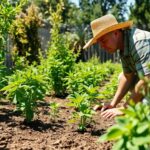What's better compost or topsoil

Welcome to Our In-Depth Comparison: Compost vs Topsoil
When it comes to gardening and landscaping, understanding the role of compost and topsoil is essential for the health and success of your plants. Both materials are crucial for providing nutrients, improving soil structure, and fostering plant growth, but they serve different purposes in the garden. In this article, we will delve into the benefits and uses of compost and topsoil, helping you determine which option is better suited for your gardening needs. Whether you're a seasoned gardener or just starting out, this guide will equip you with the knowledge to make an informed decision for a lush and vibrant garden.
Topsoil or compost for flower beds
Imagine stepping into a garden where the flowers are so vibrant, the colors so rich, and the blooms so bountiful that you can't help but feel wonder and awe. This isn't a fantasy; it's the potential reality of your garden when you harness the power of the right soil amendments. Now, you might be standing at the crossroads of decision: to choose the foundational topsoil, rich in minerals and structure or to enrich with compost, a treasure trove of organic matter and nutrients.
Unlocking the secrets to a flourishing garden is not just a matter of planning and planting; it's about nurturing the very ground your flowers spring from. The use of either topsoil or compost can dramatically affect not only the health of your plants but also their ability to fight off pests and diseases.
Topsoil is the uppermost layer of soil, containing the highest concentration of organic matter and microorganisms. It's often referred to as the "A horizon" by soil scientists, and its nutrient-rich composition provides the perfect starting point for establishing a new garden bed or replenishing an old one.
On the other hand, compost is decomposed organic material, the end product of a natural recycling process. It's dark, crumbly, and teeming with life – from beneficial bacteria to fungi, all working in harmony to break down organic material into nutrient-rich humus.
So, which is the secret ingredient for your garden's success? The answer may surprise you, as it's not a simple choice but a dynamic blend that can propel your flower beds into a state of abundance. Let's dig deeper and reveal why you can't afford to overlook the potential of these soil superchargers:
1. Nutrient Boost: Compost is packed with essential nutrients that release slowly over time, ensuring your flowers have a consistent supply of the food they need to thrive.
2. Water Retention: Both topsoil and compost improve soil structure, influencing how well soil retains water and how easily roots can penetrate the ground.
3. Disease Suppression: The microorganisms in compost play a crucial role in suppressing soil-borne diseases, which could be the difference between a failed plant and a thriving one.
4. Biodiversity: Using compost increases the biodiversity of your soil, creating a more resilient garden ecosystem that can handle the challenges of pests and changing weather patterns.
The truth is, your flower beds are silently screaming for attention – for that perfect blend of topsoil and compost that will be the bedrock of their success. The question is no longer whether to use topsoil or compost, but how to combine them to create an environment where your flowers can't help but flourish.
Curious about how to mix these elements for optimal growth? Stay tuned, as we're about to unveil the tips and tricks that will transform your garden into a captivating canvas of color and life – a space that will be the envy of every gardener in the neighborhood. Your flowers are waiting, and the time to act is now. Don't let another season pass by without tapping into the secret world beneath our feet.
Topsoil or compost for lawn
Imagine stepping outside onto a lush, vibrant carpet of grass that not only feels like a plush green paradise underfoot but also boasts the kind of magazine-cover aesthetics that make neighbors green with envy. The secret to achieving such a lawn masterpiece is not just in regular watering or mowing—it's in the foundational elements that nourish and sustain it. The eternal debate between the use of topsoil and compost could be the defining factor in elevating your lawn from mediocre to magnificent.
But which of these should you choose? The answer might surprise you.
Topsoil is the uppermost layer of soil, which generally contains a mixture of organic matter, minerals, and nutrients. It's the go-to for leveling your yard or repairing bare patches. However, there is another contender in the ring—compost. This dark, nutrient-rich gold is the product of decomposed organic matter, including leaves, vegetable scraps, and even coffee grounds. When it comes to creating a thriving ecosystem beneath your feet, compost can be transformative.
Here's the twist: you might not have to choose at all. The synergy between topsoil and compost can create the ultimate soil blend for your lawn. By integrating the best of both worlds, your grass receives an unparalleled boost in health and vitality. But how exactly does this dynamic duo work together to unlock the full potential of your lawn?
- Structure and Drainage: Topsoil adds bulk and structure, while compost improves drainage and aeration, ensuring that water and nutrients penetrate deeply to reach the roots.
- Nutrient-Rich: Compost is teeming with essential nutrients that feed your grass, fostering strong growth and a robust root system.
- Microbial Activity: Beneficial microbes in compost work tirelessly to break down organic material, releasing even more nutrients into the soil for your lawn to absorb.
But that's not all. There's a catch that most lawn care aficionados overlook—timing. Knowing when and how to apply this dynamic soil duo can mean the difference between a good lawn and a truly spectacular one.
If you're itching to transform your outdoor space into a verdant wonderland, stay tuned. Discover the insider tips and timing tricks that will empower you to harness the full potential of topsoil and compost. Your dream lawn is closer than you think, and with a few strategic moves, you can unlock a lush landscape that will be the talk of the town. Don't let your lawn be an afterthought—make it a centerpiece. The journey to a breathtaking yard begins now. Are you ready to take the first step?
Compost or top soil for vegetable garden
When it comes to cultivating a thriving vegetable garden, the secret lies beneath the surface. Imagine sinking your hands into rich, nutrient-dense earth, the kind that promises a bounty of plump tomatoes, crisp greens, and vibrant carrots. The dilemma of choosing between compost and topsoil can be a crucial decision that sets the stage for your garden’s success.
First, consider compost, the gardener's gold, teeming with beneficial microorganisms and organic matter that works wonders in improving soil structure. It's a product of careful decomposition, a symphony of once-living materials transformed into a powerhouse of nourishment for your plants. Integrating compost into your garden beds can:
1. Boost soil fertility and nutrient content
2. Enhance moisture retention
3. Encourage robust root development
4. Promote a balanced ecosystem within your soil
On the flip side, topsoil is the uppermost layer of the earth, offering a foundational base for gardens. It's the unsung hero, often taken for granted, yet it holds the potential to support a garden from the ground up – quite literally. Quality topsoil should be:
- Rich in minerals
- Free of contaminants
- Full of organic matter
- Well-aerated and loose
The intrigue doesn't end with just the individual benefits of these two options. What if you didn't have to choose? The alchemy of blending compost with topsoil could be the elixir your garden is thirsting for, a perfect marriage of structure and sustenance.
But the journey to a flourishing garden is lined with more than just choosing the right soil amendment. There are secrets, tips, and tricks that can elevate your gardening game to new heights. Are you ready to discover the full potential of your garden's soil? Stay tuned, as we delve deeper into the world of soil amendments, unlocking the door to an abundant harvest that will be the envy of your neighborhood.
Difference between topsoil and compost
Unveiling the secrets of a vibrant garden, many overlook the subtle yet critical elements that are the backbone of lush greenery. The debate often lies dormant beneath our feet, unseen but paramount: the underworld of gardening - the magical realm of topsoil and compost.
Are you ready to be the gardening savant who effortlessly nurtures a blooming paradise? Understanding the distinction between these two soil superheroes can be the game-changer for your gardening endeavors.
Imagine the earthy, rich hues of healthy plants that could adorn your garden. It all starts with the soil. Topsoil serves as the foundation, a layer of life that is home to a complex community of organisms. It's the top layer of the earth's surface, a place where roots stretch and grow, seeking the stability and nutrients essential for plant health.
On the flip side, compost is the alchemist of the garden, a dynamic transformer of waste into gold. It's a concoction of decomposed organic matter teeming with life, offering a banquet of nutrients that supercharges the soil's fertility.
But what if I told you that the interplay between these two is where the true magic happens?
1. Texture & Composition: Dive into the world where the blend of minerals, air, and moisture in topsoil contrasts against the rich, organic nature of compost.
2. Role in the Garden: Each serves a unique purpose - topsoil provides the structure, while compost offers the nourishment.
3. Usage: Discover when and how to use each to maximize plant vitality and yield.
The key to unlocking your garden's potential lies in the precise application of these elements. Timing and technique are everything, and the right knowledge can elevate your garden to a wonderland of productivity and beauty.
Feel the thrill of anticipation, the eagerness to delve deeper into this topic, as we explore the dynamic dance between topsoil and compost. Your garden is a canvas, and with these insights, you're about to create a masterpiece. Stay tuned, for the journey into the heart of your garden's soil is just beginning.
Can I use compost instead of topsoil for grass
Imagine unlocking the lush, vibrant lawn of your dreams. It's within reach, but what if the secret ingredient isn't what you've always been told it is? The conventional wisdom might push you towards topsoil, but the savvy gardeners are turning their eyes to a surprising alternative: compost.
What sets compost apart isn't just its potent fertility. It's about its incredible sustainability and its remarkable ability to revitalize your lawn at the most fundamental level. Think of it not just as a substitute for topsoil, but as a transformational elixir for your garden.
The benefits of using compost include:
1. Enhanced soil structure
2. Increased water retention
3. A boost in essential microorganisms
Each point marks not a simple improvement, but a quantum leap in gardening efficacy. You're not just laying a foundation; you're building an ecosystem.
But how does compost achieve these feats, and why might it be the superior choice for your grass? The answer lies in its rich composition, teeming with organic matter that topsoil often lacks. This matter doesn't just feed your grass; it rebuilds the soil from the inside out.
Intrigued? You should be. The implications of choosing compost over topsoil are vast and could mean the difference between a lackluster lawn and a verdant paradise. The world is catching on, and the fear of missing out is real. Don't let this opportunity slip through your fingers like so much sterile soil. Transform your lawn. Choose compost. Your grass will thank you.
Consejo final: Consider the specific needs of your garden when choosing between compost and topsoil. Compost is rich in nutrients and beneficial organisms, making it ideal for improving soil health and fertility. Topsoil, on the other hand, is a good foundation layer and can be enhanced with compost. For the best results, you may find a combination of both compost and topsoil suits your garden's requirements. Wishing you a bountiful and healthy garden!
 Can you plant immediately after tilling
Can you plant immediately after tilling Does tilling cause more weeds
Does tilling cause more weeds Do I need to remove weeds before tilling
Do I need to remove weeds before tilling What is better a tiller or cultivator
What is better a tiller or cultivator Can you plant vegetables without tilling
Can you plant vegetables without tillingIf you want to know more about similar articles like What's better compost or topsoil you can visit category Gardening Tools.
Deja una respuesta